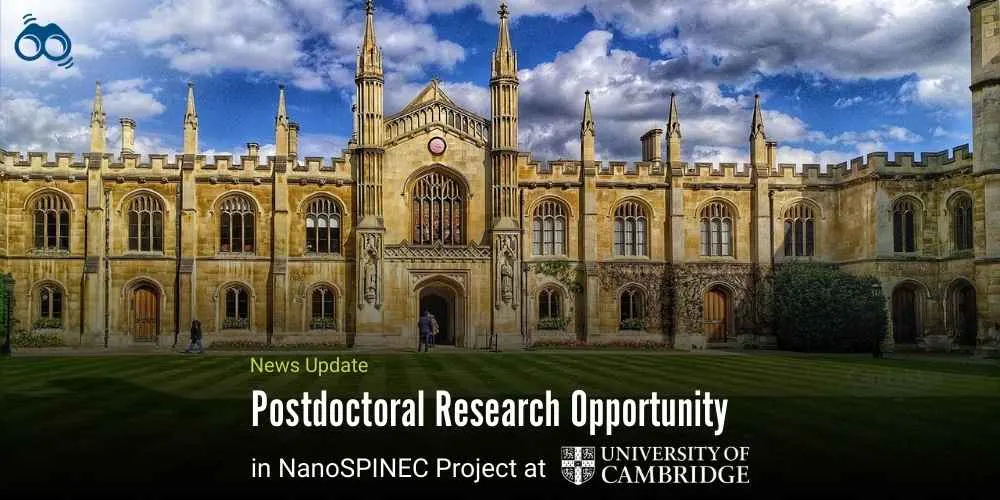University of Cambridge Expands Global Quantum Research with New Fellowship
NanoSPINEC Project Signals New Era in UK–US Scientific Collaboration
Cambridge University, known for its excellence in research, has recently announced a new postdoctoral research opportunity, a part of an ambitious international collaboration at the intersection of chemistry , physics and quantum science. A two-year research post has been created as a part of NanoSPINEC, which is a groundbreaking project backed by UK and US science funders. Under this project, experts will explore the behaviour of tiny particles inside the molecules at their quantum level, mainly in their spin state. Aimed to measure spins at room temperature using single molecules. If the project becomes successful, it will lead to major advances in quantum technology, which will help us to understand chemical processes. This project will merge quantum science, nanotechnology and molecular chemistry, pushing the boundaries of what is possible in quantum engineering.
For two years, the post has been fixed-term by mutual consent of the EPSRC of the United Kingdom and the NSF of the United States. NanoSPINEC is a remarkable project, examining spin entanglement and chemistry at the nanoscale, ultimately aiming for the first room-temperature measurements of spin states at the single-molecule level, which could pave the way for new avenues in quantum technologies and molecular science.
The candidate will be required to support the development of new experiments and data analysis, assisting in taking the NanoSPINEC project forward. The position is part of a joint effort by three Cavendish Laboratory research groups: the NanoPhotonics Centre, the Optoelectronics Group, and the AMOP Group. The project furthermore entails close cooperation with the University of California, San Diego, involving travel in order to work alongside the theorist collaborators there. This demonstrates an increase in the number of international university research projects being funded by Cambridge.
Candidates should possess, or be nearing completion of, a PhD in physics, chemistry, or a related field. Familiarity with nanoscale optical dynamics or ODMR would be an asset. Applicants should also be willing to work interdisciplinarily and be able to help build optical spectroscopy apparatuses and prepare samples. Familiarity with plasmonics, metamaterials, molecular emitters, or quantum control of nanoscale systems would be an asset. The UK NanoPhotonics Centre, leading this research, works extensively throughout the University of Cambridge, in association with chemical engineering research UK departments, materials science, and cancer research departments. The centre is also in contact with a number of large EU programmes as well as industrial partners and provides extensive academic research opportunities within the UK.
Applicants who have lodged their PhD but have not yet obtained their award will be appointed as Research Assistants. It is anticipated that on confirmation of their PhD, they will move to the status of a Research Associate (Grade 7). This is in line with common Cambridge University postdoc practice and follows general university employment openings within the UK. The role is for two years in the first instance, and is one of the broader range of research associate roles and research assistant jobs at Cambridge. It also supports the university's postgraduate education and research commitment, and helps to develop future talent, such as international students at Cambridge. Informal inquiries can be made to Dr Rakesh Arul, and applicants are invited to cite reference KA47296 in all correspondence. The University of Cambridge remains committed to equality, diversity, and inclusion in all aspects of recruitment.
Editor's Note:
This University of Cambridge announcement is a thrilling development in quantum research. Through the integration of chemistry, physics, and nanotechnology, the NanoSPINEC project is poised to investigate how molecules react at the smallest levels, particularly how their spin states can be quantified at room temperature. This matters because it would enable scientists to construct new forms of quantum devices that function under normal conditions, rather than specialised labs. What is particularly notable about this project is that it is international in scope and interdisciplinary. Backed by both UK and US science funders, and closely working with researchers in California, it demonstrates how worldwide collaboration is leading to innovation. It also demonstrates Cambridge's increasing influence in determining the future of quantum engineering. Looking forward, the results of this work might have implications in many fields,ranging from medical diagnosis to secure communication and novel materials. If things go well, it could lead us to think about chemical processes in new terms and present us with technologies we cannot even imagine yet. This project also sponsors early-career researchers and enhances postgraduate training, which is crucial for creating future scientists.
Skoobuzz believes that the NanoSPINEC project not only represents a bold scientific venture but also a statement of intent about the direction of future research. By uniting disciplines, institutions, and nations, it sets a precedent for how grand scientific challenges can be tackled. Its outcomes may reshape our understanding of chemistry and quantum behaviour, while also cultivating the next generation of researchers who will carry this momentum forward.
FAQs
1. How do I apply for postdoctoral research at Cambridge?
To apply for postdoctoral positions at the University of Cambridge:
- Candidates should consult the university’s official job listings to identify current vacancies.
- Applications typically require a curriculum vitae (CV), cover letter, and academic references.
- Eligibility usually includes holding,or being close to completing,a PhD in a relevant discipline.
- Applicants must cite the job reference number in all correspondence (for example, KA47296 for the NanoSPINEC role).
- Cambridge also provides support networks for postdoctoral researchers, including mentoring schemes and career development resources.
2. What is the NanoSPINEC project at Cambridge University?
NanoSPINEC stands for Nanoscale Spin Entanglement and Chemistry. It is:
- A pioneering research initiative based at the Cavendish Laboratory.
- Jointly funded by the UK’s Engineering and Physical Sciences Research Council (EPSRC) and the US National Science Foundation (NSF).
- Focused on measuring quantum spin states in single molecules at room temperature.
- Designed to explore quantum entanglement in chemical systems, potentially for the first time.
- A collaboration between Cambridge and the University of California, San Diego, involving nanophotonics, optoelectronics, and theoretical physics.
- If successful, the project could transform quantum sensing, molecular diagnostics, and our understanding of chemical reactions at the quantum level.
3. Are there research associate jobs at UK universities?
Yes, research associate roles are widely available across UK universities. For example:
- Institutions such as Oxford, Sheffield, and Cambridge regularly advertise fixed-term and permanent research posts.
- These roles span disciplines including biomedicine, engineering, social sciences, and quantum physics.
- Applicants typically require a PhD and experience in experimental or theoretical research.
- Positions may be listed under titles such as Research Associate, Research Assistant, or Postdoctoral Fellow.
4. Why choose Cambridge for postdoctoral research?
Cambridge offers:
- A globally recognised research environment, consistently ranked among the top universities worldwide.
- Access to interdisciplinary collaborations and over 300 postgraduate programmes.
- Strong institutional support, including college affiliations, mentoring schemes, and career development services.
- International partnerships and alumni networks that enhance long-term career prospects.
- A vibrant academic community with opportunities for teaching, publishing, and industry engagement.
Its reputation, resources, and collaborative culture make it a strategic choice for postdoctoral researchers seeking impact and growth.
5. What departments offer postdoc opportunities in Cambridge?
Postdoctoral roles at Cambridge are available across a wide range of departments, including:
- Department of Physics – such as the Cavendish Laboratory and NanoPhotonics Centre.
- Department of Chemistry – supporting fellowships and interdisciplinary projects.
- Department of Engineering – including quantum devices and materials science.
- Departments of Zoology, Biochemistry, Psychiatry, and Computer Science – offering roles in life sciences, artificial intelligence, and health research.
- Research Institutes – including the Cancer Research UK Cambridge Institute, the MRC Biostatistics Unit, and the Sainsbury Laboratory.
These departments regularly offer opportunities for early-career researchers to contribute to world-leading science and innovation.














0 Comments (Please Login To Continue)